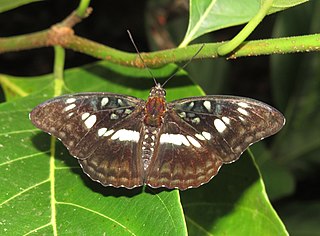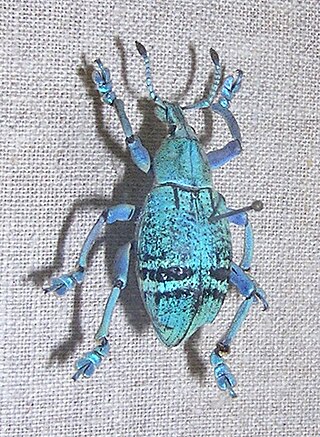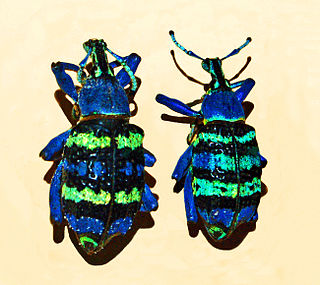
Acraea terpsicore, the tawny coster, is a small, 53–64 millimetres (2.1–2.5 in), leathery-winged butterfly common in grassland and scrub habitats. It belongs to the Nymphalidae or brush-footed butterfly family. It has a weak fluttery flight. It is avoided by most insect predators. This species and the yellow coster are the only two Indian representatives of the predominantly African tribe Acraeini. It is found in India, Sri Lanka, Maldives to Myanmar, Thailand, Laos, Cambodia, Vietnam, Bangladesh, Singapore, and recently Australia

Eurema hecabe, the common grass yellow, is a small pierid butterfly species found in Asia, Africa and Australia. They are found flying close to the ground and are found in open grass and scrub habitats. It is simply known as "the grass yellow" in parts of its range; the general term otherwise refers to the entire genus Eurema.

Luthrodes pandava, the plains Cupid or cycad blue, is a species of lycaenid butterfly found in India, Sri Lanka, Myanmar, United Arab Emirates, Indochina, Peninsular Malaysia, Singapore, Taiwan, Java, Sumatra and the Philippines. They are among the few butterflies that breed on plants of the cycad class.

This glossary of entomology describes terms used in the formal study of insect species by entomologists.

Euchrysops cnejus, the gram blue, is a small butterfly that belongs to the lycaenids or blues family. It is found from India to Australia. The species was first described by Johan Christian Fabricius in 1798.

Athyma ranga, the blackvein sergeant, is a species of nymphalid butterfly found in south-west India, Cambodia and parts of Southeast Asia.

The Indian fritillary is a species of butterfly of the nymphalid or brush-footed family. It is usually found from south and southeast Asia to Australia.

Eupholus is a genus of beetle in the family Curculionidae. The genus includes some of the most colourful of the weevils. The colour may serve as a warning to predators that they are distasteful. Most species feed upon yam leaves, some of which are toxic to other animals. The species occur in New Guinea and adjacent islands. This genus was described by French entomologist Jean-Baptiste Alphonse Dechauffour de Boisduval in 1835.

Catochrysops strabo, the forget-me-not, is a small butterfly found in Asia that belongs to the lycaenids or blues family. The species was first described by Johan Christian Fabricius in 1793. It is found in Sri Lanka, India, from Sikkim to Indochina and in Sundaland, Sulawesi and the Philippines.

Eupholus bennetti is a species of beetle belonging to the family Curculionidae.

Eupholus chevrolati is a species of beetle belonging to the family Curculionidae.

Eupholus geoffroyi is a species of beetle belonging to the family Curculionidae.

Eupholus magnificus is a species of beetle belonging to the family Curculionidae.

Eupholus schoenherrii is a species of beetle belonging to the family Curculionidae. Eupholus petitii is sometimes included here as a subspecies.

Eupholus petitii is a disputed species of beetle belonging to the family Curculionidae.

Eupholus tupinierii is a species of beetle belonging to the family Curculionidae.

Eupholus humeridens is a species of beetle belonging to the family Curculionidae.

Rhinoscapha maclayi is a species of true weevil family.

Eupholus nickerli is a species of beetle belonging to the family Curculionidae.

Sphiximorpha willistoni, or Williston's wasp fly, is a rare species of syrphid fly found in eastern North America. It is a strong wasp mimic. Hoverflies can remain nearly motionless in flight. The adults are also known as flower flies for they are commonly found on flowers, from which they get both energy-giving nectar and protein-rich pollen. Larvae in this genus are found in sap runs of trees.




















